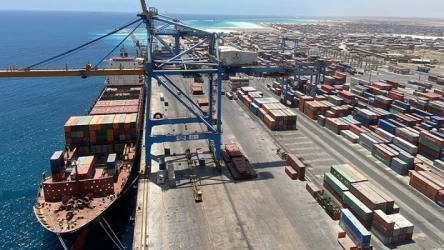Sea transportation of home appliances and furniture from Iran to the Netherlands
Relocating from one country to another involves several logistics, and when shipping household goods and furniture internationally, sea freight is often the most economical and practical choice. If you’re moving from Iran to the Netherlands, understanding the sea freight process will help you plan a smooth and efficient move. This article outlines everything you need to know about shipping your household items, furniture, and other belongings by sea from Iran to the Netherlands.
1. Why Choose Sea Freight for Shipping Household Goods?
Sea freight is one of the most popular options for moving large quantities of goods internationally, especially when compared to air freight. Here are some reasons why sea freight is ideal for shipping household goods:
- Cost-Effective: Sea freight is generally more affordable than air freight, particularly for larger shipments.
- Capacity: Sea freight can accommodate bulky or oversized items, such as furniture, appliances, and heavy household goods.
- Safety: With proper packing, sea freight ensures that your items, even fragile ones, arrive safely at their destination.
2. Preparing Household Goods for Shipment
Before your belongings are shipped from Iran to the Netherlands, careful preparation is essential to ensure they arrive in the best condition possible.
a. Create an Inventory List
Make a detailed inventory list of all the items you're shipping. This will help with customs declarations and allow you to keep track of your belongings during transit. Be sure to include the condition of high-value items for insurance purposes.
b. Packing Your Goods
Proper packing is crucial for protecting your items during transit. Use high-quality materials like bubble wrap, packing peanuts, and sturdy boxes to secure smaller items. For large furniture or delicate items, consider using custom crating or professional packing services. Disassembling furniture can save space and reduce the risk of damage.
c. Necessary Documentation
Shipping internationally requires specific documentation to clear customs. Ensure you have:
- A complete inventory of the items.
- Proof of ownership for valuable goods (receipts, photos).
- A valid passport and visa (if applicable).
- Customs forms required for entry into the Netherlands.
3. Choosing the Right Shipping Method
When shipping by sea, you have a couple of options depending on the size of your shipment.
a. Full Container Load (FCL)
If you have a large shipment, an FCL service may be the best option. With FCL, you will have an entire shipping container to yourself, reducing the chances of your goods being mixed with others. This option is more efficient for large moves, especially when transporting multiple pieces of furniture or large appliances.
b. Less than Container Load (LCL)
If your shipment is smaller, you can opt for LCL shipping. This means your goods will be consolidated with other shipments in one container. While this can save money, it might take longer as the container must be filled with other items, and the goods must be handled multiple times.
4. Choosing a Reliable Shipping Company
Selecting a reputable and experienced shipping company is essential for a smooth shipping experience. When choosing a sea freight company for your move from Iran to the Netherlands, consider the following:
- Experience in International Moves: Choose a company that specializes in international shipping, particularly to the Netherlands.
- Comprehensive Services: Look for a company that offers door-to-door services, including packing, loading, unloading, and customs clearance.
- Insurance Options: It’s important to choose a company that offers shipping insurance to protect your belongings during transit.
Ask for quotes from multiple companies to compare prices and services. Ensure they have transparent pricing policies with no hidden fees.
5. Customs Regulations for Shipping to the Netherlands
Before shipping household goods and furniture to the Netherlands, you need to be aware of the country's customs regulations to avoid delays and extra costs. Key points to remember:
- Customs Duty and VAT: Household goods are often exempt from customs duty if you've lived outside the Netherlands for at least one year. However, you may still need to pay VAT on certain items.
- Restricted Items: Certain goods, such as hazardous materials, food, plants, and animals, may be restricted or prohibited from entering the Netherlands. Make sure you check with your shipping company or a customs broker to ensure you comply with all regulations.
- Documentation: To qualify for tax exemptions or reduced duties, you’ll need documents proving your residency status, including your passport, visa, and proof of residence.
A customs broker or the shipping company itself can assist you in navigating these regulations.
6. Shipping Timeline
The shipping timeline can vary based on the shipping method, route, and other factors. On average, shipping from Iran to the Netherlands takes between 25 and 45 days, depending on the type of service you choose. Here's a breakdown of the typical shipping process:
- Booking and Preparation: 1-2 weeks to prepare the goods and schedule shipping.
- Transit Time: Sea freight shipping typically takes between 25 and 40 days, depending on the port of departure, sea route, and potential delays.
- Customs Clearance and Delivery: After arriving at the port in the Netherlands, customs clearance can take 1-2 weeks, and then your goods will be delivered to your address.
7. Cost of Shipping Household Goods from Iran to the Netherlands
The cost of shipping household goods via sea freight depends on several factors:
- Size of the Shipment: Larger or heavier shipments will cost more to ship.
- Shipping Method: FCL will be more expensive than LCL because you’re using an entire container.
- Distance and Route: Different ports in Iran and the Netherlands have different shipping times and costs. Shipping from larger ports may be more economical.
- Insurance: It’s advisable to insure your belongings during transit, and this will incur additional costs.
It’s best to get multiple quotes to compare pricing, services, and estimated delivery times.
8. Insurance for Shipping
Since shipping household goods and furniture can involve risks such as damage, theft, or loss during transit, it’s crucial to consider purchasing shipping insurance. Most shipping companies offer insurance options, which generally cover the value of your goods during transit.
While insurance is not mandatory, it provides peace of mind and financial protection in case something goes wrong. The cost of insurance is usually based on the declared value of the goods being shipped.
9. Delivery in the Netherlands
Once your goods arrive at the designated port in the Netherlands, they will go through customs clearance. After clearing customs, the shipping company will deliver the items to your new home, either directly to your address or to a nearby location.
Some shipping companies offer full-service options, including unpacking and setting up your furniture, while others may only provide door-to-door delivery.
10. Final Steps: Unpacking and Settling In
Upon receiving your household goods, take inventory to ensure everything is in good condition. If you have opted for insurance, file a claim immediately if any items are damaged or lost. If necessary, arrange for professional help with unpacking and assembling furniture.
Conclusion
Shipping household goods and furniture from Iran to the Netherlands by sea is an affordable and efficient option for international moves. By understanding the process, choosing the right shipping method, and preparing all necessary documents, you can ensure your belongings are safely transported. Whether you're moving to the Netherlands for work, study, or a new life chapter, proper planning and reliable shipping companies will make your relocation smooth and hassle-free.
If you have any specific questions or need further assistance, feel free to ask!











